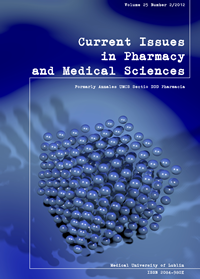Health behavior of patients after myocardial infarction
DOI:
https://doi.org/10.12923/j.2084-980X/25.2/a.05Słowa kluczowe:
myocardial infarction, health-relation behavior, patientAbstrakt
Secondary prevention for patients after myocardial in farction in addition to pharmacotherapy includes life style modification. Patients should strengthen their health, eliminating the negative health behaviors. The aim of the study was to analyze the health behavior of patients after myocardial infarction. The study included 268 patients. The research tool was a questionnaire developed by the authors. The analysis included changes in daily life of patients, paying attention to diet, attitudes towards smoking, physical activity and caring for health manifested in self- monitoring of blood pressure, regular visits to the doctor and taking medication regularly. The influence of gender, age, place of residence, education level on the declared changes, was studied. The results were statistically analyzed. It has been found that in the event of myocardial infarction, which a serious illness is, the patient’s behavior and involvement in creating a healthy life style changes. Patients attach more attention to eating habits, physical activity, and cessation of smoking. These declarations of ten refer to people in middle age, whereas young people do not under take such efforts, especially against cigarette smoking. Majority of them self-monitor blood pressure, keep the files of measurements, systematically take medicines and visit the doc tor as well as de vote more time to rest and recreation. Complex, multi-specialized, and long-term care of patients after myocardial infarction is the most op ti mal model of preventive and therapeutic procedure in these patients. Qualified medical personnel with the active participation of patient’s family members should carry it out.
Bibliografia
1. Barwicka K., Krześniak H.: Program rehabilitacji przedrentowej Zakładu Ubezpieczeń Społecznych. Zdr. Publ., 112, 516, 2002.
2. Bellwon J., Rynkiewicz A.: Epidemiologia chorób układu krążenia. in: Kardiologia. Podręcznik oparty na zasadach EBM. Szczeklik A., M. Tendera (editors). Medycyna Praktyczna. p. 283, 2009.
3. Critchley J.A., Capewell S.: Mortality risk reduction associated with smoking cessation in patients with coronary heart disease: a systematic review. JAMA, 290, 86, 2003.
4. Grupa Robocza Europejskiego Towarzystwa Kardiologicznego do spraw postępowania w ostrym zawale serca z uniesieniem odcinka ST: Wytyczne do tyczące postępowania w os trym zawale serca z uniesieniem odcinka ST. Kardiol. Pol., 1(supl.2), 2009.
5. Malina T., Rybicki A. and Buczkowski B.: Częstość powrotów do pracy zawodowej chorych na chorobę niedokrwienną serca po drugim etapie rehabilitacji. Pol. Merk. Lek., 1, 99, 1996.
6. Magiera T. Prewencja wtórna po ostrych zespołach wieńcowych. Lek. Rodz., 15, 908, 2010.
7. Marchioli R. et al.: Early protection against sudden death by n-3 polyunsaturated fatty acids after myocardial infarction. Circulation, 105, 1897, 2002.
8. Matyjaszczyk P., Hoffmann K. and Bryl W.: Epidemiologia wybranych czynników ryzyka chorób układu krążenia. Przegląd Kardiodiabetologiczny, 6, 255, 2011.
9. Oldridge N. et al.: Effects on quality of life with comprehensive rehabilitation after acute myocardial infarction. Am. J. Cardiol., 67, 1084, 1991.
10. Szostak W.B., Cybulska B.: Prewencja chorób sercowo-naczyniowych - postępy 2006. Medycyna Praktyczna, 5, 23, 2007.
11. van de Verf F. et al.: ESC Guidelines for management of acute myocardial infarcion in patients presenting with persistent ST – segment elevation: The Task Force on management of ST–segment elevation acute myocardial infarction of the European Society of Cardiology (ESC). Eur. Heart. J., 29, 2909, 2008.
12. Warburton D.E.R., Nicol C.W. and Bredin S.S.D.: Health benefits of physical activity: the evidence. CMAJ, 174, 801, 2006.
13. Wood D. et al.: Nurse-coordinated multidisciplinary, family-based cardiovascular disease prevention programme (EUROACTION) for patients with coronary heart disease and asymptomatic individuals at high risk of cardiovascular disease: a paired, cluster-randomised controlled trial. Lancet, 371, 1999, 2008.
Pobrania
Opublikowane
Numer
Dział
Licencja
Prawa autorskie (c) 2012 Autorzy

Praca jest udostępniana na licencji Creative Commons Attribution-NonCommercial-NoDerivatives 3.0 Unported License.


